Unlike the Peace Silver Dollar and the Morgan Dollar, the 1944 Wheat Penny is not made of silver, which makes it significantly less valuable in terms of metal content. However, that doesn’t mean this coin isn’t worth money!
In fact, some specimens can be incredibly valuable if you’re lucky enough to find one. The obverse features Abraham Lincoln, making it especially appealing to collectors who admire historical figures.
Because of this, many collectors are eager to own this coin in any condition—it serves as a tangible piece of American history, honoring one of the most iconic and beloved U.S. presidents.
Let’s dive into the varieties, historical background, key features, and grading process of the 1944 Wheat Penny!
1944 Wheat Penny Details
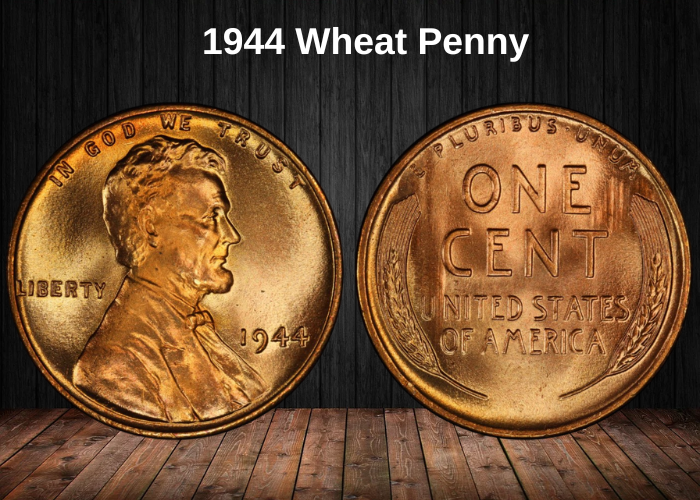
- Category: Wheat Lincoln Penny
- Mints: Philadelphia, Denver, San Francisco
- Mintage: 2.2 billion
- Designer (Obverse/Reverse): Victor D. Brenner
- Composition: 95% Copper, 5% Zinc and Tin
- Face Value: $0.01 (One Cent)
- Weight: 3.11 grams (0.1097 ounces)
- Melt Value: $0.0257
- Diameter: 19.05 mm (0.748 inches)
- Edge: Plain
The 1944 Wheat Penny is a favorite among coin collectors due to its historical design and high mintage.
Obverse Design
The obverse features a right-facing profile of Abraham Lincoln, the 16th President of the United States, known for preserving the Union and issuing the Emancipation Proclamation in 1863.
Above Lincoln’s head is the national motto “IN GOD WE TRUST.” The word “LIBERTY” appears to his left, and the year “1944” is displayed just below his chin.
Coins minted in Denver and San Francisco carry a “D” or “S” mint mark beneath the date, while Philadelphia issues lack a mint mark.
Reverse Design
The reverse displays the coin’s denomination “ONE CENT” in bold letters at the center, with “UNITED STATES OF AMERICA” just below it in two lines. Above the denomination is the motto “E PLURIBUS UNUM,” meaning “Out of many, one.”
Two stylized wheat stalks arch along the left and right edges, giving this penny its nickname—the Wheat Penny.
Metal Composition & Value
Though not made of precious metals, the 1944 Wheat Penny consists of 95% copper and 5% tin and zinc. Its melt value is around $0.0257, depending on current copper prices. Despite its modest metal value, collectible examples—especially rare errors—can sell for much more.
| 1944 Wheat Penny Value Chart | ||||
| Mint Mark | Good | Fine | Extra Fine | MS62 |
| 1944 No Mint Mark Wheat Penny Value | – | – | – | $6 |
| 1944 D Wheat Penny Value | – | – | – | $6 |
| 1944 S Wheat Penny Value | – | – | – | $5 |
| 1944 Steel Wheat Penny | – | – | – | $55,000 |
1944 Wheat Penny Grading
To determine the value and condition of any coin, it must be graded. Grading assesses a coin’s wear, luster, strike, and overall appearance. The most widely accepted grading system is the Sheldon Scale, developed by Dr. William Sheldon, a renowned numismatist.
This scale ranges from 1 to 70, with 1 representing a heavily worn coin with barely identifiable features, and 70 indicating a perfect, flawless coin with no signs of wear even under magnification.
Below is a simplified breakdown of the Sheldon Coin Grading Scale:
| Sheldon # | Grade | Description |
|---|---|---|
| 1 | Basal State-1 | Barely recognizable, heavily worn |
| 2 | Fair | Very heavily worn |
| 3 | Very Fair | Design visible but flat |
| 4–6 | Good | Major details clear, very worn |
| 7–10 | Very Good | Some detail visible |
| 12–15 | Fine | Moderate wear, clear details |
| 20–30 | Very Fine | Light even wear, sharp details |
| 40 | Extremely Fine | Minor wear on high points |
| 50 | About Uncirculated | Slight trace of wear |
| 60 | Mint State (MS 60) | Uncirculated, minor marks or dull |
| 65 | Mint State (MS 65) | Well-struck, high quality |
| 70 | Mint State (MS 70) | Perfect, flawless under magnifier |
This standardized scale is internationally recognized and forms the foundation for accurate coin valuation and authentication.
1944 Wheat Penny Value and Varieties Guide
The 1944 Wheat Penny was struck at three different mints—San Francisco, Denver, and Philadelphia—resulting in three distinct varieties. Additionally, there’s the rare 1944 Steel Penny, which stands out as a unique error issue from that year.
With a total mintage surpassing 2 billion, the 1944 Wheat Penny is among the most widely produced U.S. coins. Due to this massive quantity, these coins generally hold little value in lower grades and are considered quite common.
In most cases, 1944 pennies in fine to extremely fine condition are valued between $0.20 and $0.50, regardless of the mint they came from.
That said, certain error versions or higher-grade specimens can command significantly higher prices. Depending on the nature of the error and the coin’s preservation, some can be worth $500 or more on the collector’s market.
1944 No Mint Mark Wheat Penny Value
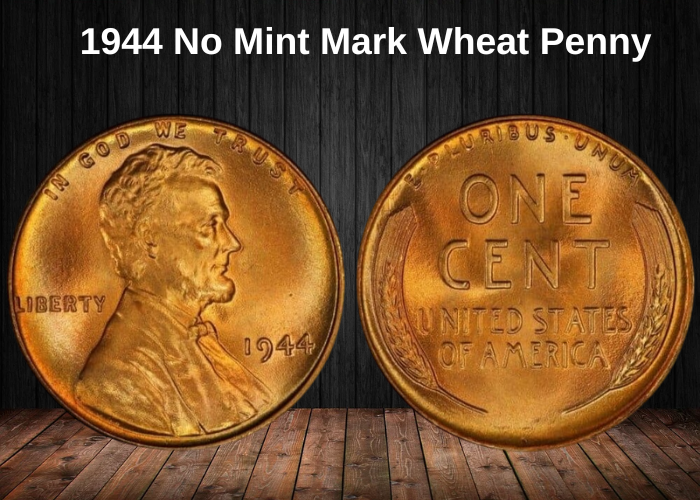
- Mint: Philadelphia
- Designer: Victor D. Brenner
- Mintage: 1,435,400,000
- Composition: 95% copper, 5% zinc and tin
- Mass: 3.11 grams (0.1097 ounces)
- Face Value: $0.01 (one cent)
- Diameter: 19 mm (0.74803 inches)
- Shape: Round
- Edge: Plain
- Category: Wheat Lincoln Penny
- Mint Mark: None
- Thickness: 1.5 mm (0.06 inches)
The 1944 Wheat Penny struck in Philadelphia carries no mint mark and holds the record for the highest production in the series, with over 1.4 billion coins minted. Because of their abundance and easy availability, these coins generally carry low value—often less than a quarter in circulated condition.
Most examples found today show signs of wear, such as scratches, dings, or faded details. In uncirculated condition, a 1944 Philadelphia Wheat Penny is typically valued at around $0.90. Coins graded between MS60 and MS65 may fetch a few dollars each.
However, specimens in pristine condition, such as those graded MS66, can command prices of up to $28. In some cases, collectors might be willing to pay even more at auctions, depending on the coin’s visual appeal and rarity in that grade.
1944 S Wheat Penny Value

- Mint: San Francisco
- Designer: Victor D. Brenner
- Mintage: 282,760,000
- Composition: 95% copper, 5% zinc and tin
- Mass: 3.11 grams (0.1097 ounces)
- Face Value: $0.01 (one cent)
- Diameter: 19 mm (0.74803 inches)
- Shape: Round
- Edge: Plain
- Category: Wheat Lincoln Penny
- Mint Mark: S
- Thickness: 1.5 mm (0.06 inches)
The 1944 Wheat Pennies produced at the San Francisco Mint had the lowest mintage among the three minting facilities that year. Because of their relative scarcity, they tend to hold a slightly higher value compared to their Philadelphia counterparts. In circulated or fine condition, these coins generally sell for between $0.30 and $0.60.
In uncirculated condition, the 1944-S Wheat Penny can be valued at around $5, while those graded at MS66 or higher can fetch up to $26 or even more—especially if the coin is free from major imperfections.
The most desirable coins in the series tend to be those with mint marks (S or D) that exhibit rare errors, such as repunched mint marks or the D/S over-mint mark variety, which can significantly increase their value among collectors.
1944 D Wheat Penny Value
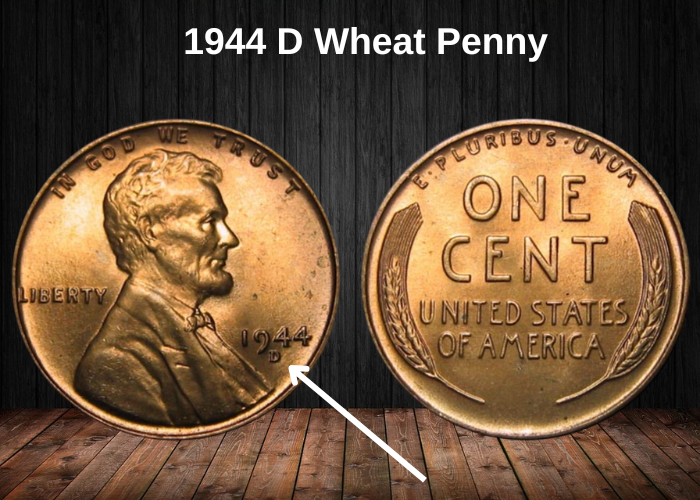
- Mint: Denver
- Designer: Victor D. Brenner
- Mintage: 430,578,000
- Composition: 95% copper, 5% zinc and tin
- Mass: 3.11 grams (0.1097 ounces)
- Face Value: $0.01 (one cent)
- Diameter: 19 mm (0.74803 inches)
- Shape: Round
- Edge: Plain
- Category: Wheat Lincoln Penny
- Mint Mark: D
- Thickness: 1.5 mm (0.06 inches)
The 1944-D Wheat Penny was produced in large numbers, with over 430 million coins struck at the Denver Mint, making it the second most minted variety in the series. Like the other 1944 Wheat Pennies, the value of a circulated coin is relatively low—around $0.20 in fine condition and approximately $0.40 in extra fine condition.
In mint state (MS62), the value can climb to about $6, with higher-grade specimens, such as those graded MS66, potentially selling for several hundred dollars depending on eye appeal and rarity.
Particularly valuable are the error varieties. One notable example is the 1944-D penny with a D over S mint mark, which sold for $2,100, highlighting how rare errors can significantly increase the coin’s worth.
1944 Steal Wheat Penny Value
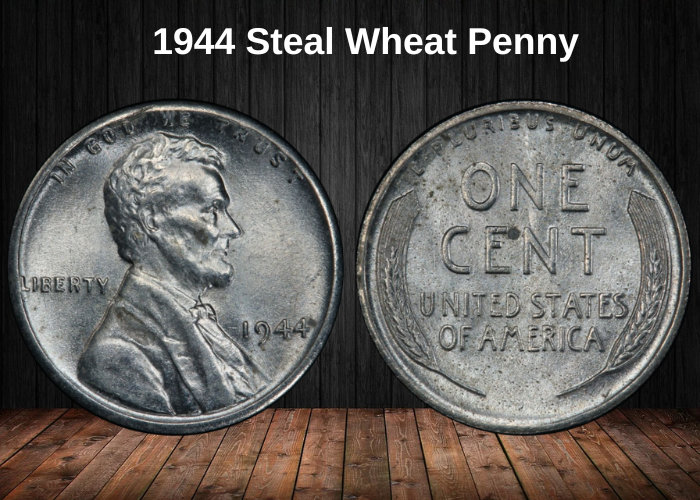
- Mint: Philadelphia, San Francisco, Denver
- Designer: Victor D. Brenner
- Mintage: Unknown
- Composition: Zinc-coated steel
- Mass: 2.7 grams (0.095 oz)
- Face Value: $0.01 (one cent)
- Diameter: 19 mm (0.74803 inches)
- Shape: Round
- Edge: Plain
- Category: Wheat Lincoln Penny
- Mint Mark: D
- Thickness: 1.5 mm (0.06 inches)
Among all 1944 Wheat Pennies, the steel variety stands out as the rarest and most valuable. Why is that?
These steel cents are considered minting errors by many numismatists because by 1944, the U.S. Mint had already returned to using copper planchets, making any steel coins from that year a striking anomaly.
The exact number of these coins produced remains unknown, but experts estimate that only 24 authentic 1944 steel pennies exist today. Their rarity significantly boosts their market value.
Even in lower grades, these coins can command impressive prices, starting at around $38,500 and climbing as high as $165,000 or more, depending on condition and mint mark.
1944 Wheat Penny History
The Lincoln Wheat Penny series was minted from 1909 to 1958, with the design introduced to honor the 100th anniversary of Abraham Lincoln’s birth in 1809.
The iconic design was created by Victor David Brenner, a renowned sculptor. His initials, VDB, can be seen on the obverse side of the coin. Interestingly, Brenner had developed a version of this design years before the coin was officially commissioned. When then-President Theodore Roosevelt came across the design, he was impressed and supported its use. Roosevelt, a great admirer of Lincoln, considered himself a follower of Lincoln’s ideals, which helped push the design into production.
The 1944 Wheat Penny also has deep ties to World War II. During this time, the U.S. government needed to conserve copper for the war effort, especially for ammunition and other military supplies. As a result, the 1943 pennies were struck using zinc-coated steel. However, these steel coins were problematic—they rusted easily and were often mistaken for dimes, which caused public dissatisfaction.
In response, the U.S. Mint returned to using copper in 1944, creating the standard version of that year’s Wheat Penny. Despite this, a small number of 1944 pennies were mistakenly struck on leftover steel planchets from the previous year. These 1944 Steel Pennies are now considered one of the rarest and most valuable minting errors in U.S. coin history.
Although some experts debate whether these are true errors or simply the result of a failed material transition, their rarity and backstory make them highly prized among collectors today.
Rare 1944 Wheat Penny Errors List
1944 Wheat Penny Doubled Die Error

The double die error occurs when a coin die is accidentally imprinted twice during the hubbing process, leading to a visible doubling of certain design elements. This creates the illusion of two slightly offset images on a single coin.
On the 1944 Wheat Penny, this error typically appears on the date (1944), the word “LIBERTY,” and occasionally around Lincoln’s eyes. Although not as dramatic or rare as other minting errors, a 1944 Wheat Penny featuring this kind of doubling can still be worth around $5 or more, depending on its condition and the clarity of the doubling.
1944 Wheat Penny Missing Dot Error
Some 1944 Wheat Pennies were minted with a subtle but notable error: the dot missing in the American motto “E PLURIBUS UNUM.” This punctuation omission, though small, is significant due to its rarity and makes these coins particularly appealing to collectors.
Because of its scarcity, a 1944 Wheat Penny with the missing dot can fetch around $8 to $10, depending on the coin’s overall condition and level of preservation. As with most errors, coins in higher grades command better prices.
1944 Wheat Penny Clipped Planchet Error
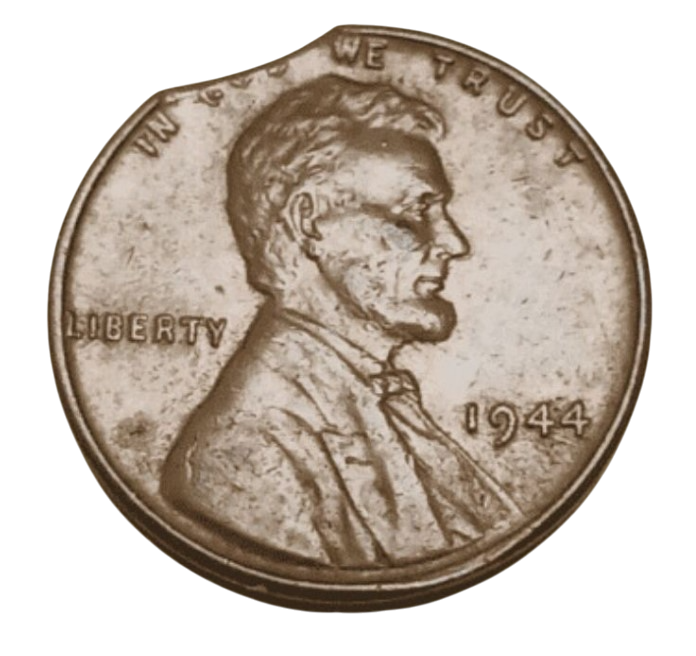
Clipped coin errors occur when a coin is struck on an incomplete (clipped) planchet, usually due to an error during the blanking process when the metal sheet is punched. This results in a portion of the coin being visibly missing.
Collectors often prefer larger clips, as they are more dramatic and visually appealing. The value of a 1944 Wheat Penny with this error can range from $12 to $100, depending on the size of the clip and the coin’s overall condition.
1944 Wheat Penny S over D Mark Error
Some 1944 Wheat Pennies feature an error where an incorrect mint mark was initially struck, and then corrected by punching the right mint mark over it. This is known as a repunched mint mark (RPM). When viewed under magnification, remnants of the original mint mark are often clearly visible.
One notable example is the 1944-D over S Wheat Penny, where a Denver mint mark (D) was struck over a San Francisco mint mark (S). Coins with this error can fetch around $130 or more, depending on their grade and overall condition.
Where to sell your penny?
Now that you know the value of your penny, you might be wondering where to sell it. Don’t worry: here’s a guide to some of the best online platforms where you can easily sell your coins, along with their advantages and disadvantages.
Discover the best platforms for selling coins online (pros and cons).
1944 Wheat Penny FAQ
1. Why is the 1944 Wheat Penny significant in U.S. coinage history?
The 1944 Wheat Penny marks the return to copper coinage after the steel cent experiment of 1943. Due to backlash from the public over the rusting and confusion with dimes, the U.S. Mint returned to a bronze alloy for cents. However, due to continued war demands, the composition changed to include recycled materials — copper from spent shell casings. This makes the 1944 cent not only historically symbolic but also literally made from war remnants.
2. What is the metal composition of the 1944 Wheat Penny?
The 1944 cent is composed of approximately:
- 95% copper
- 5% zinc
Unlike pre-1943 cents, tin was removed from the alloy. The Mint used recycled ammunition shell casings, giving these coins the nickname “shell case cents.” The result was a softer, more reddish-brown coin.
3. Are there rare error varieties of the 1944 Wheat Penny?
Yes! The most famous and valuable is the 1944 Steel Penny, an error coin mistakenly struck using leftover 1943 steel planchets. Known varieties include:
- 1944 Steel Cent (Philadelphia, Denver, or San Francisco) – Extremely rare; only a few known.
- 1944 D/S Overmintmark – A Denver mintmark struck over a San Francisco mintmark.
- Die breaks, lamination errors, and off-center strikes are also collectible if in good condition.
4. How can you tell if you have a 1944 Steel Penny instead of the common copper one?
You can test it by:
- Magnet Test: Steel cents are magnetic, copper cents are not.
- Weight: A copper 1944 cent weighs around 3.11 grams, while a steel one weighs about 2.7 grams.
- Color: Steel pennies have a silvery zinc appearance; copper ones are reddish-brown.
If it passes these tests, have it professionally authenticated, as fakes are common.
5. How many 1944 Wheat Pennies were made?
Massive numbers were minted to meet wartime demand:
- Philadelphia (no mint mark): 1,435,400,000+
- Denver (D): 430,578,000+
- San Francisco (S): 282,760,000+
This makes the 1944 Wheat Penny one of the most common coins of the Wheat series.
6. What is the value of a 1944 Wheat Penny today?
In circulated condition, most 1944 pennies are worth:
- $0.05 to $0.25 depending on condition. In uncirculated grades:
- MS-63 Red: $3–$5
- MS-65 Red: $10–$20+ Rare varieties like the 1944 Steel Penny can sell for $75,000 to over $150,000, depending on the mint mark and grade.
7. How do collectors grade 1944 Wheat Pennies, and what should they look for?
Collectors look at luster, strike sharpness, and color (Red, Red-Brown, or Brown):
- Red coins are the most valuable in high grade.
- Check for clean surfaces, no wear on Lincoln’s cheek and jaw, and strong wheat stalk details.
- Mint state coins should have no circulation marks and full original shine.



















































